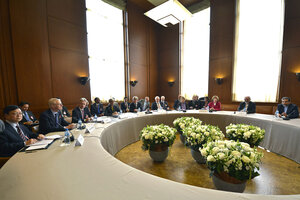Iran nuclear talks move forward, but are world powers offering enough?
Negotiators have a new two-phase plan to halt expansion of Iran's nuclear program before a final deal, but the plan does not ease most punishing sanctions.

A general view shows participants before the start of two days of closed-door nuclear talks at the United Nations offices in Geneva, Switzerland, Thursday, Nov. 7, 2013.
Martial Trezzini, Keystone/AP
Geneva
Iran and world powers are exuding optimism after nuclear talks resumed in Geneva today, but it is unclear whether a new two-stage American plan to temporarily halt expansion of Iran's nuclear program includes enough incentives for Iran to sign on.
As closed-door talks began, following a positive first round three weeks ago and two days of detailed technical discussions in Vienna last week, diplomats say prospects for a deal have never been better. Iran’s top negotiator, Foreign Minister Javad Zarif, told Reuters after the first session this morning that "We are making progress, but it's tough." Earlier he said a deal here is possible “if all parties do their best.”
A senior US official before the talks described a first step lasting perhaps six months that would stop Iran’s nuclear program “from moving forward for the first time in decades,” in exchange for “limited, targeted, and reversible sanctions relief.”
But the oil and financial sanctions, the most punishing of the slew of sanctions imposed on Iran, would remain in place through the initial phase of perhaps six months, the official said. Iran may not consider the plan, which is being put forward by the P5+1 (the US, Britain, France, Russia, China, and Germany), sufficiently balanced, nor does the plan appear to address Iran's insistence that it define an end result, up front, that permits uranium enrichment in Iran for verifiably peaceful purposes.
Also not clear is whether Washington appreciates how little time Iran’s new centrist President Hassan Rouhani may have for dealmaking. He is under pressure to improve Iran’s economy in months, not years, and also under attack by hardliners accusing him of being willing to cave in to Western demands.
Yet both sides have demonstrated an unprecedented political will to explore a deal, which could ease mutual mistrust.
The Iranians will have noted that the Obama administration has pulled out all the stops in the past 10 days to prevent Iran hawks in Congress from imposing more sanctions as the sensitive process unfolds. And the Americans will have registered how Iran’s Supreme Leader Ayatollah Ali Khamenei last weekend gave his backing to Iran’s nuclear negotiating team as “sons of the revolution,” and warned hardliners to back off in their criticism.
'Time on the clock'
The initial deal would “put time on the clock,” said the senior US official, perhaps giving a “crucial” six months on nonexpansion of Iran’s nuclear efforts, during which the final agreement could be reached.
Last Friday in Istanbul, Zarif lambasted past “zero-sum” approaches that did not solve the nuclear conundrum. He said Iran was ready to “do everything … to ensure that even the perception that Iran has anything but peaceful intentions for its nuclear program will be removed, because we believe that even the perception that Iran pursues a nuclear weapons program is not only wrong, but dangerous.”
The first step, the US official said, “must” include capping levels of uranium enrichment, stockpiles of enriched material, the capacity of Iran’s nuclear facilities, and verification and monitoring.
At issue is the fate of Iran’s enrichment of uranium to 20 percent purity – a level useful to fuel Iran’s small research reactor that produces medical isotopes, but only a few technical steps from weapons-grade material.
The bulk of Iran’s 18,000 centrifuges – with only 10,000 or so currently spinning – now produce reactor fuel at less than 5 percent purity. Iran has signaled that it is willing to halt its 20 percent production, and convert its current stockpile into oxide for fuel, essentially making it very difficult to later use for a bomb.
Expanding the menu
At the first round of Geneva talks last month, Zarif sketched out a broad framework of an Iranian plan, with details provided by Deputy Foreign Minister Seyed Abbas Araghchi. In Vienna, experts from both sides “drilled down further," according to the US official.
“We have a menu of options that allow us to mix and match [incentives], depending upon what Iran is willing to do,” said the senior US official. “What the end of that agreement looks like, quite frankly, is going to take a lot of time to negotiate.”
The official asserted that sanctions have been "key" to bringing Iran to the negotiating table, but also gave a robust defense of a pause in imposing any new sanctions, echoing White House officials who have lobbied hard on Capitol Hill in recent days.
“If there is only a 10 percent chance that additional sanctions would put at risk those negotiations – and quite frankly, we believe it’s higher than 10 percent – we all have an obligation not to take that risk,” said the US official.
Iran rejects that assertion, noting that it offered a proposal in 2005 that also imposed similar limits on its nuclear program – when there were no nuclear-related sanctions on Iran.
The US prevented European negotiators from accepting that 2005 offer, in line with its no-enrichment policy.
But new sanctions now, “when in fact Iran [has] begun serious negotiations, it will say to our P5+1 partners we’re not serious about the negotiation, the United States of America isn’t serious, because we’re willing to put the negotiation at risk by taking additional unilateral action,” said the US official.

